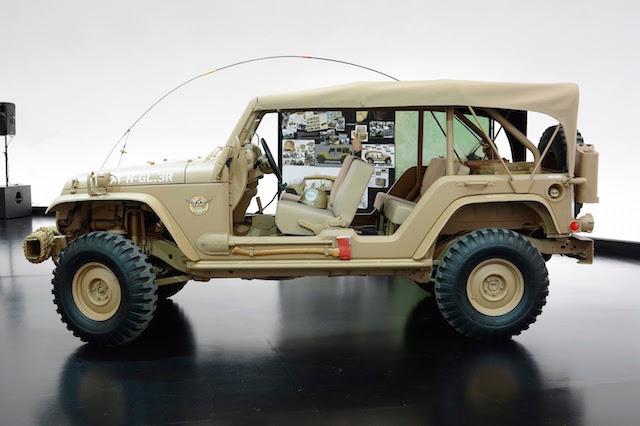
New Zealanders will next year be able to salute modern editions of the vehicle that helped the Allies win World War II, the all-American Jeep.
Jeep celebrates its 75th birthday in 2016 and is preparing special anniversary models to honour the crucial role the 1941 original 4WD played in the defeat of the Axis nations, Germany, Italy, and Japan.
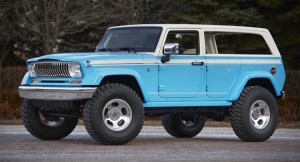
“Jeep will have some surprises in its 75th year,” said Greg MacDonald, the NZ brand manager for Chrysler, Jeep, Dodge, “and we as the importer will be involved with that.”
Jeep hinted earlier this year at what might be among the birthday brigade when it showed off seven concept models at its annual American off-road shindig in Utah, the so-called Easter Safari.
But its executives played dead on 2016 plans. Said Jeep president and CEO Mike Manley: “We go to this event each year to showcase our latest Jeep production vehicles, as well as a variety of new ideas in our concept vehicles.
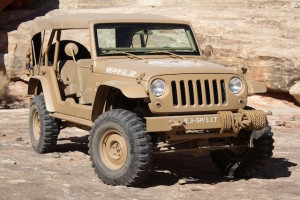
“In doing so, we receive a tremendous amount of valuable feedback, while interacting with our customers in the Jeep brand’s natural environment.”
The only indication of what 2016 will bring came from Jeep’s European boss Steve Zanlunghi, who this week told reporters in Britain that it will be “a year-long celebration with different events.” Asked if it involved new models, he said: “You’ll see soon. It starts on January 1.”
Most of the concepts at the Easter Safari were reincarnations of sorts. There was the canvas-roofed Staff Car, based on the four-door Wrangler Limited Rubicon but resembling the military original with its bench seats, round headlights, rear-mounted spare tyre and vintage petrol can. It ran a V6 Pentastar V6 petrol engine mated to a six-speed manual gearbox and rode on 16-inch wheels.

The Wrangler Africa was also Rubicon-based and described as the ultimate Jeep for back-country expeditions, with room for extra gear and auxillary fuel tanks. Its had an extended rear end, high-top roof, rode on 17-inch body-coloured steel wheels, and used a 2.8-litre turbodiesel engine mated to a six-speed automatic gearbox.
The Wrangler-based Jeep Chief echoed the full-size Jeep Cherokee of the 1970s. Its exterior design cues include a vintage Ocean Blue exterior colour scheme with a white roof; a modified razor grille that the original Wagoneer made famous; halogen headlamps; removable sides; chrome front and rear bumpers and classic, 17-inch slotted mag wheels. It used the V6 petrol engine.
Whatever Jeep reveals for its anniversary year, it is all part of plans to broaden its model range to double annual sales to 1.9 million vehicles over the next five years. CEO Manley has said he wants to “unlock the potential of some of the world’s largest markets.”
Original Jeep: ‘Faithful as a dog, strong as a mule, agile as a goat’
Jeep likes to tell the story of the American soldier in Germany in 1945 who stopped three Germans from escaping behind Allied lines.
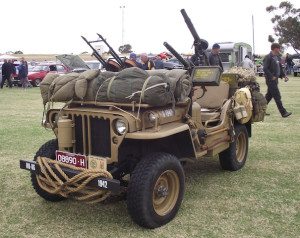
The Germans were dressed in US Army uniforms and riding in a US Army Jeep – two regular soldiers in the front and a colonel in the back.
As the Jeep approached a checkpoint, the GI figured something was wrong with the seating arrangement. American colonels don’t sit in the back seat, he told himself. American colonels drive the vehicle.
The GI stopped the Jeep, told the occupants they sure as hell didn’t belong to Uncle Sam’s Army, and marched them off at gunpoint to the guardhouse.
Jeep can tell these stories because, unlike every other 4WD maker today, it was there when Hitler tried to turn the world on its ear.
It was there before Land-Rover, the Toyota Land Cruiser, Nissan Patrol and Mitsubishi Pajero … before the concept of 4WDs had been fully explored.
The Allied Commander, General Dwight Eisenhower – later to become US President – said the Allies would not have won World War II without the Jeep.
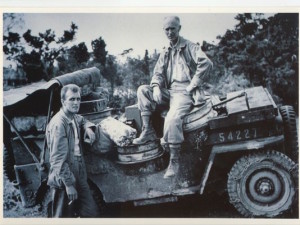
The GIs loved it. Famous US war correspondent Ernie Pyle said in the early 1940s: “I don’t think we could continue the war without the Jeep.
“It does everything. It goes everywhere. It’s as faithful as a dog, as strong as a mule and as agile as a goat.
“It carries twice what it was designed for, and keeps on going. It doesn’t even ride so badly after you get used to it.”
The flat Jeep bonnets became altars for US Army chaplains and poker tables for GIs. The fold-down windscreen allowed the use of stretchers for the wounded.
“It does everything except bake a cake,” said one officer. It even powered a fridge to make ice cream for GIs hungry for a taste of Stateside.
